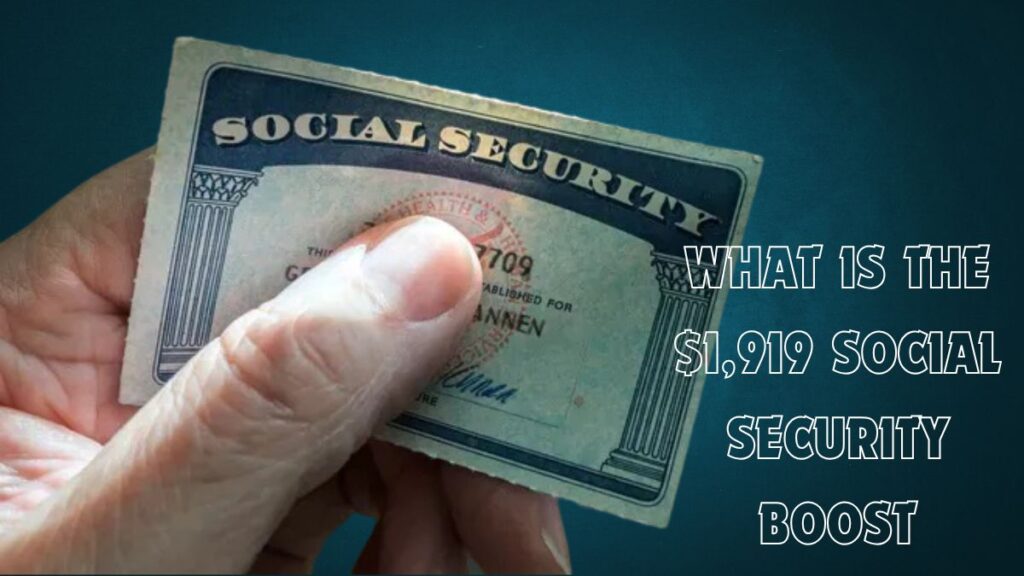Who’s Getting the $1,919 Social Security Boost in April 2025
The just-introduced-to-be-traded Social Security benefits, which will be arriving in April 2025, is just making waves, especially following the news that the increase can amount to as much as $1,919 for the recipients. The possible increases in the monthly benefits will decidedly enhance the lives of some pensioners and other Social Security benefit recipients. For others, however, as would always be the case with any money transfer, it is always better to be sure of the numbers behind the hearsay.
We will now cover the social security increase of $1,919 in April 2025, when and to whom it will be delivered, the effect which the trade will have on special social security beneficiaries, and how it will be calculated. While this increase may sound like a fairy tale, let us finally and once and for all have a very clear and precise idea of the process through which social security bills are dispatched and to whom the payments are made.
What Is the $1,919 Social Security Boost

The $1,919 boost is an estimated average Social Security retirement benefit for an individual who begins taking advantage in 2025 at age FRA. The FRA for human beings born in and after 1960 is age 67. This is the cool gain amount based on estimates as of date, including the yearly Cost of Living Adjustment (COLA).
The Social Security Administration (SSA) increases benefits every year by only inflation as reported by the Consumer Price Index for Urban Wage Earners and Clerical Workers (CPI-W). In times of inflation, the SSA prefers to increase Social Security fees so that the recipient will be in a position to pay for the higher cost of living. It is called the COLA increase.
In 2025, a COLA boost of roughly 3% is estimated to amount to roughly $1,919 in contrast to the month in the case of an individual who’s only recently started prospering at full retirement age. Yet all Social Security beneficiaries are no longer receiving this exact figure.
How Is Social Security Payment Amount Determined?
It is interesting to learn how Social Security benefits are determined. One useful method of understanding who gets the $1,919 increase and why others get an irregular figure higher or lower than that is to differentiate.
1. Primary Insurance Amount (PIA)
Your Primary Insurance Amount (PIA) is the foundation of your Social Security benefit. Your PIA is determined from your total common listed monthly earnings (AIME) and calculation of your entire 35-year highest earnings. Your earnings are adjusted for inflation and are utilized to calculate the PIA.
2. Full Retirement Age (FRA)
The rate of the Social Security gain computation is progressive in the sense that more percent of pre-retirement income is received by lower-paid workers than higher-paid workers. It means that Social Security pays the lower-paid workers more than it pays the higher-paid workers.
Social Security is theirs at age sixty-two, but if you retire them before your full retirement age (FRA), your monthly benefit will be reduced. The reduction will be based on the number of months you receive benefits before reaching your FRA.
[also_read id=”144″]
People who delay their blessings after FRA will earn more. For instance, if you begin receiving blessings after FRA, you get on-time retirement credits, which add to your benefit by 8% every year until you are age 70.
3. Cost of Living Adjustment (COLA)
Annually, the SSA increases Social Security benefits for inflation. When inflation has risen in proportion to the CPI-W, the SSA will increase all Social Security benefits with a COLA adjustment so that beneficiaries can locate the money to pay for increasing costs. In 2025, projected COLA growth will be around 3%, increasing monthly benefits on a mass scale.
Who Will Get the $1,919 Social Security Raise?
The $1,919 April 2025 boost is the average monthly Social Security benefit for retirement age recipients. There are a couple of important distinctions to remember regarding exactly how well this actual figure is calculated and who would be most likely to receive a greater or lesser amount.
1. The Ones Receiving at Full Retirement Age (FRA)
Individuals who attain full retirement age (sixty-seven) in 2025 and start receiving Social Security benefits have a median monthly benefit of around $1,919. That is the average human beings will get in case they take benefits through their FRA.
It is worth noting that full retirement age varies from person to person. For those born before 1960, full retirement age may be lower. But for individuals born in the year 1960 and onwards, FRA could be sixty-seven.
2. Higher Earners (Above Average Benefits)
They become eligible for greater Social Security benefits if they earned more in their lifetime. They can get more in monthly benefits than the $1,919 amount if they earn more AIME.
For instance, the highest Social Security increase for those beginning at FRA in 2025 will be approximately $3,500 depending on the month. That maximum is for individuals who had the best-earning years in their working years and paid the most into Social Security.
If you worked for years earning good salaries in a high-paying position and paid the most Social Security taxes, your FRA bill every month might be well above average. They might not get an increased benefit based on earnings, but the COLA increase would be added to their higher benefit too, with the increase indexed for inflation.
3. Early Claimers (Smaller Benefits)
Whereas the $1,919 common cost is what you would receive if you start Social Security at full retirement age (67), if you prefer to take Social Security benefits earlier, starting at age 62, you will receive much less. Social Security limits monthly blessings if taking it before FRA, so you can take into account the extra amount of time that you will receive the benefits.
If you start taking Social Security at age 62, the reduction can be as good a bargain as 30% of your monthly benefit. Someone who would be eligible for $1,919 per month at FRA, for example, might get around $1,343 per month if retiring at age 62.
To view the payoffs to payments, one must view the payoff to be realized and when it is most advisable to buy. Early claiming is associated with smaller lifetime benefits, although it is highly probable the most desirable for anyone who needs money sooner or experiences health issues which will cause him or her to be less capable of working further into an extended period of retirement.
4. Delayed Claimants (Increased Benefits)
Conversely, individuals who postpone receiving their Social Security benefits until after full retirement age will receive more per month. For every 12 months you postpone receiving benefits after FRA (through age 70), your benefit is boosted in the following manner: 8% for each year. What this means is that individuals who postpone receiving benefit until age 70 can also receive more-than-average benefits.
[also_read id=”149″]
For example, if you have been eligible for $1,919 at FRA, age 70, your benefit will be boosted by about $1,275 depending on the month to about $3,194 a month.
Facors That Affect Social Security Payments Beyond the $1,919 Increase

While the $1,919 a month median rate is the ideal target for full retirement age recipients, note that there are numerous variables that can affect your actual Social Security benefit, including:
1. Spousal and Survivor Benefits
Social Security provides extra benefits to married couples through spousal benefits and survivor benefits. The most qualified spouse gets the other spouse’s Social Security pension when the partner reaches the FRA. A partner qualifies to receive 100% of the deceased partner’s benefit after being married for ten years or more.
These marriage credits may increase your minimum family of relatives Social Security benefit; however, they are not the automatic $1,919 anymore.
2. Working While Receiving Social Security
Some human beings continue working since they do receive Social Security. If you are under the full retirement age and you have two paintings, your blessings might be restricted if you earn above a certain sum. In the year 2025, your earnings will be about $21,240 every year. Your earnings should be above that otherwise, your benefits temporarily will decrease.
But then, once you’re already at FRA, there is no cap on earnings, and you can earn your full Social Security benefit no matter how much you earn.
3. Taxes on Social Security Benefits
Another one to remember is that Social Security benefits become taxable to those who receive other income. If you have total earnings above some thresholds, you will probably be paying federal earnings tax on as much as 85% of your blessings. For higher earners, it may cut into the amount of actual benefit you collect each month.
Conclusion : Reality of the $1,919 Bump
Your Social Security benefit average in April 2025 could be $1,919, the month’s matching figure. That’s a guess, however. Your payment can be estimated based on a broad array of factors, including your earnings history, when you take your benefits, and if you qualify for extra benefits like spousal or survivor benefits.
Early filers will pay less each month but late filers receive more payment, as much as $1,919 more. The 2025 COLA is very important because it will increase the benefits so that they can match the inflation.
[also_read id=”138″]
If you are retiring, it is much more important that you know how your Social Security benefits are calculated and how your choice of when to begin receiving them will affect your long-term financial health. Your thoughtful consideration of choices open to you will enable you to gain the most benefit for yourself in the optimal situation available to you for your needs and retirement objectives.
FAQ’s
Q. What is the April 2025 $1,919 Social Security boost?
A. It’s the projected average monthly benefit received by retirees taking Social Security at full retirement in 2025.
Q. Who qualifies for the $1,919 a month Social Security benefit?
A. Individuals starting to claim Social Security at age 67 in 2025 who are making a good income might be entitled.
Q. Will everyone who receives Social Security qualify for $1,919?
A. No, only those claiming at full retirement age on average earnings receive it; others receive more or less.
